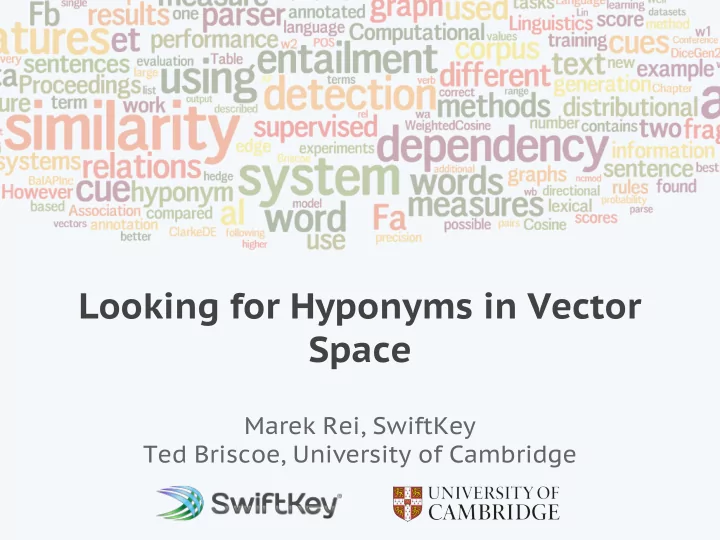

Looking for Hyponyms in Vector Space Marek Rei, SwiftKey Ted Briscoe, University of Cambridge
Hyponymy Hyponymy is a ‘ type-of ’ relation hyponym → hypernym car, ship, train → vehicle scarlet, crimson, vermilion → red therapy, medication, rehabilitation → treatment Applications in NLP: ● Information Retrieval ● Summarisation ● Paraphrasing ● etc.
Tasks Hyponym detection Kotlerman et al. (2010), Baroni & Lenci (2011) Italian → language ? Hyponym acquisition Hearst (1992), Caraballo (1999), Snow et al. (2005) … our international program offers courses in several different languages such as Italian and Spanish, and the student is able to choose ... Hyponym generation ? → language Output: Italian, Spanish, Chinese, Estonian, English, ...
Evaluation Dataset Training (1230 hypernyms), development (922 hypernyms) and test (922 hypernyms) sets. ● Contains all hyponyms for each hypernym ● Extracted from WordNet ● Includes indirect hyponyms and synonyms ● Excludes low-frequency hypernyms On average, each hypernym in the dataset has 233 hyponyms, but the distribution is roughly exponential, and the median is 36.
Vector similarity Method: Scoring a large pool of candidates using vector similarity. Candidates: words in BNC with 10+ frequency (86,496 words) Candidate Score for (? → language) Correct Italian 0.35 TRUE Spanish 0.22 TRUE culture 0.21 FALSE English 0.18 TRUE Spain 0.15 FALSE
Vector spaces 1. Window Word co-occurrences in a context window of 3 on either side, PMI weighting. 2. Collobert & Weston (2008) Neural network for predicting the next word in the sequence. Learns dense vector representations for each word. 3. Mnih & Hinton (2007) Hierarchical log-bilinear (HLBL) neural network. Learns to predict the vector representation for the next word in the sequence.
Vector spaces 4. Word2vec Feedforward neural network for efficient learning of word representations. Predicts surrounding words based on the current word. (Mikolov et al., 2013) 5. Dependencies The text was parsed with RASP (Briscoe et al., 2006) and features extracted from dependency relations, weighted with PMI. CW and HLBL were trained on RCV1, others on BNC. Download: www.marekrei.com/projects/vectorsets/
Experiments with vector spaces Using cosine as a scoring function
Vector offset method Modelling semantic relations by vector offset (Mikolov et al., 2013) Can we apply this to hyponym generation?
Vector offset method
Vector offset method bird bird - fish + salmon bird - red + crimson bird - treatment + therapy bird salmon bird bird mammal bird crimson therapy same-sized goose long-winged mammal reptile tern flightless hedgehog butterfly pheasant moorhen sambar wader plover reptile reptile lizard pipit lizard lizard insect gull sea-bird moorhen long-winged warbler babirusa butterfly tern smoked butterfly frugivorous
Weighted cosine We propose properties for a directional measure: 1. The shared features are more important to the directional score calculation, compared to the non-shared features. 2. Highly weighted features of the broader term are more important to the score calculation, compared to features of the narrower term.
Similarity measures Method Precision@1 Precision@5 Pattern-based 8.14 4.45
Similarity measures Method Precision@1 Precision@5 Pattern-based 8.14 4.45 Cosine* 25.41 14.90 Lin* 21.17 12.23 DiceGen2* 21.82 14.55
Similarity measures Method Precision@1 Precision@5 Pattern-based 8.14 4.45 Cosine* 25.41 14.90 Lin* 21.17 12.23 DiceGen2* 21.82 14.55 WeedsPrec 0.11 0.04 WeedsRec 0.54 2.41 BalPrec 17.48 11.34 BalAPInc 15.85 9.66
Similarity measures Method Precision@1 Precision@5 Pattern-based 8.14 4.45 Cosine* 25.41 14.90 Lin* 21.17 12.23 DiceGen2* 21.82 14.55 WeedsPrec 0.11 0.04 WeedsRec 0.54 2.41 BalPrec 17.48 11.34 BalAPInc 15.85 9.66 WeightedCosine 25.84 15.46
Similarity measures Method Precision@1 Precision@5 Pattern-based 8.14 4.45 Cosine* 25.41 14.90 Lin* 21.17 12.23 DiceGen2* 21.82 14.55 WeedsPrec 0.11 0.04 WeedsRec 0.54 2.41 BalPrec 17.48 11.34 BalAPInc 15.85 9.66 WeightedCosine 25.84 15.46 Combined 27.69 18.02
Examples scientist sport treatment researcher football therapy biologist golf medication psychologist club patient economist tennis procedure observer athletics surgery physicist rugby remedy sociologist cricket regimen
Investigating cosine Why does symmetrical cosine perform so well? 1. There are many hyponyms, compared to other relations. 2. Directional measures focus only on the narrower term. 3. Much research on hyponym detection, but not generation.
Conclusion ● Performed a systematic evaluation of different methods for hyponym generation. ● It is important to choose the correct vector space and similarity measure for a specific task. ● Symmetric similarity measures (like cosine) perform surprisingly well. ● We constructed a new measure that outperformed others on hyponym generation. ● We release three vector sets, trained on the BNC with different methods.
Conclusion Thank you!
Experiments with vector spaces Candidates: BNC vocabulary with 10+ frequency (86,496 words) Scoring function: cosine Vector space MAP Precision@1 Precision@5 Window 2.18 19.76 12.20 CW-100 0.66 3.80 3.21 HLBL-100 1.01 10.31 6.04 Word2vec-100 1.78 15.96 10.12 Word2vec-500 2.06 19.76 11.92 Dependencies 2.73 25.41 14.90
Experiments with vector spaces Candidates: BNC vocabulary with 10+ frequency (86,496 words) Scoring function: cosine
Similarity measures
Recommend
More recommend